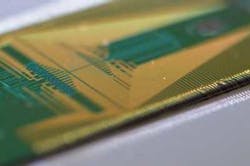An international team of quantum scientists and engineers led by the University of Bristol (Bristol, England) and involving groups from China, Denmark, Spain, Germany and Poland has created a silicon-photonics-based quantum photonic device that can entangle two photons each with dimension up to 15 (meaning that each photon exists over 15 optical paths at the same time).1 In contrast, conventional quantum hardware entangles photons (or other particles) in only two states.
Integrated quantum photonics allows the routing and control of single photons with intrinsically high stability and precision; however, to date, it has been limited to small-scale demonstrations in which only a small number of components are integrated on a chip. The new chip integrates more than 550 photonic components, including 16 identical photon-pair sources, 93 optical phase shifters, and 122 beamsplitters; as a result, it can generate, control, and analyze high-dimensional entanglement with an unprecedented level of precision.
The chip is scalable to mass-production quantities using conventional chip-making processes.
The work was done in collaboration with Peking University, Technical University of Denmark (DTU), Institut de Ciencies Fotoniques (ICFO), Max Planck Institute, Center for Theoretical Physics of the Polish Academy of Sciences, and University of Copenhagen.
Made possible by years of silicon-photonics development
"It is the maturity of today's silicon photonics that allows us to scale up the technology and reach a large-scale integration of quantum circuits," says Jianwei Wang, one of the researchers. "This is the most beautiful thing of quantum photonics on silicon. Our quantum chip allows us to reach unprecedented levels of precision and control of multidimensional entanglement, a key factor in many quantum information tasks of computing and communication."
Another researcher, Yunhong Ding from DTU, Centre for Silicon Photonics for Optical Communication (SPOC), adds, "The capabilities of our silicon photonics integrated technologies at DTU allow large scale, highly stable quantum information processing chips, which enable us to observe high-quality multidimensional quantum correlations including generalized Bell and EPR steering violations, and also to implement experimentally unexplored multidimensional quantum protocols: multidimensional randomness expansion and state self-testing."
"This silicon-photonics approach to quantum technologies provides a clear path to scaling up to the many millions of components that are ultimately needed for large-scale quantum-computing applications," says Mark Thompson, leader of the Bristol team.
Source: http://www.bristol.ac.uk/news/2018/march/silicon-quantum-photonic-technology.html
REFERENCE:
1. Jianwei Wang et al., Science (2018); doi: 10.1126/science.aar7053.
About the Author
John Wallace
Senior Technical Editor (1998-2022)
John Wallace was with Laser Focus World for nearly 25 years, retiring in late June 2022. He obtained a bachelor's degree in mechanical engineering and physics at Rutgers University and a master's in optical engineering at the University of Rochester. Before becoming an editor, John worked as an engineer at RCA, Exxon, Eastman Kodak, and GCA Corporation.

